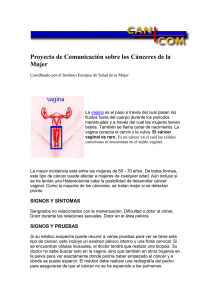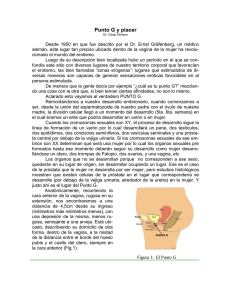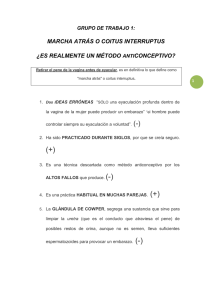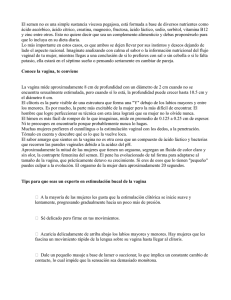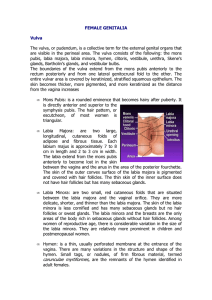fallopian tubes to the The period called a circumcision. The
Anuncio
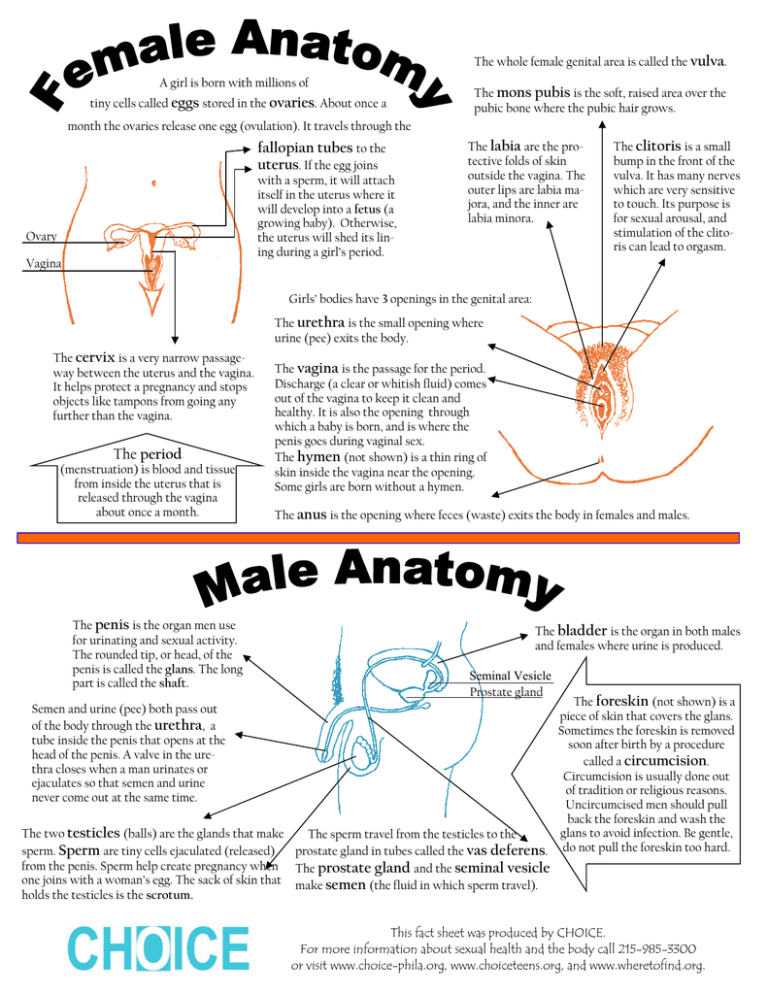
The whole female genital area is called the vulva. A girl is born with millions of tiny cells called eggs stored in the ovaries. About once a The mons pubis is the soft, raised area over the pubic bone where the pubic hair grows. month the ovaries release one egg (ovulation). It travels through the fallopian tubes to the uterus. If the egg joins with a sperm, it will attach itself in the uterus where it will develop into a fetus (a growing baby). Otherwise, the uterus will shed its lining during a girl’s period. Ovary Vagina The labia are the protective folds of skin outside the vagina. The outer lips are labia majora, and the inner are labia minora. The clitoris is a small bump in the front of the vulva. It has many nerves which are very sensitive to touch. Its purpose is for sexual arousal, and stimulation of the clitoris can lead to orgasm. Girls’ bodies have 3 openings in the genital area: The urethra is the small opening where urine (pee) exits the body. The cervix is a very narrow passageway between the uterus and the vagina. It helps protect a pregnancy and stops objects like tampons from going any further than the vagina. The period (menstruation) is blood and tissue from inside the uterus that is released through the vagina about once a month. The penis is the organ men use for urinating and sexual activity. The rounded tip, or head, of the penis is called the glans. The long part is called the shaft. The vagina is the passage for the period. Discharge (a clear or whitish fluid) comes out of the vagina to keep it clean and healthy. It is also the opening through which a baby is born, and is where the penis goes during vaginal sex. The hymen (not shown) is a thin ring of skin inside the vagina near the opening. Some girls are born without a hymen. The anus is the opening where feces (waste) exits the body in females and males. The bladder is the organ in both males and females where urine is produced. Seminal Vesicle Prostate gland The foreskin (not shown) is a piece of skin that covers the glans. Sometimes the foreskin is removed soon after birth by a procedure called a circumcision. Circumcision is usually done out of tradition or religious reasons. Uncircumcised men should pull back the foreskin and wash the glans to avoid infection. Be gentle, The two testicles (balls) are the glands that make The sperm travel from the testicles to the sperm. Sperm are tiny cells ejaculated (released) prostate gland in tubes called the vas deferens. do not pull the foreskin too hard. from the penis. Sperm help create pregnancy when The prostate gland and the seminal vesicle one joins with a woman’s egg. The sack of skin that make semen (the fluid in which sperm travel). holds the testicles is the scrotum. Semen and urine (pee) both pass out of the body through the urethra, a tube inside the penis that opens at the head of the penis. A valve in the urethra closes when a man urinates or ejaculates so that semen and urine never come out at the same time. This fact sheet was produced by CHOICE. For more information about sexual health and the body call 215-985-3300 or visit www.choice-phila.org, www.choiceteens.org, and www.wheretofind.org. Toda la zona genital de la mujer se llama la vulva. Una chica nace con millones de células diminutas, llamadas óvulos, en sus ovarios. Empezando en la pubertad, un ovario libera un óvulo cada mes en un proceso llamado ovulación. El óvulo viaja por las trompas de Falopio hacia el útero. Si el óvulo se une con un espermatazoide, se adjuntara en el útero, donde se puede desarollar en un feto (un bebe creciendo). Si no se implanta, la sangre y el tejido de sobra del utero se elimina por la vagina durante el periodo (la regla). El monte de Venus es la zona suave, situada sobre el hueso del pubis, donder crece el vello púbico. Los labios son los pliegues protectivos afuera de la vagina. Hay labios mayores (exteriors) y labios minoras (interiores). El clítoris es un montículo pequeño situado en la parte delantera de la vulva. Tiene muchos nervios muy sensibles al tacto. Su proposito es la excitación sexual. La estimulación del clitoris puede resultar en el orgasmo. El cuerpo feminino tiene 3 orficios en la zona genital: La uretra es el conducto que transporta la orina afuera del cuerpo. La cérvix (cuello del útero) es un conducto muy estrecho entre el útero y la vagina. Se proteje un embarazo y los órganos internos. Objetos como tampones no la pueden pasar. El Periodo (menstruación) es sangre y tejido de adentro del utero que se elimina por la vagina una vez por mes. La vagina es el conducto a traves del cual fluye el periodo menstrual. Flujo vaginal (un flujo transparente o blanco) sale por la vagina diariamente para mantenerla limpia y sana. También es la apertura por donde nace un bebe, y donde penetra el pene durante relaciones sexuales vaginales. El himen (no se muestra) es una membrana de piel muy fina que cubre parcialmente la entrada de la vagina. El ano es la apertura por donde salen las heces del cuerpo en ambos chicos y chicas. El pene es el organo que los hombres usan para orinar y para realizar la actividad sexual. La punta redonda, o cabeza, del pene se llama glande. La parte larga se llama tallo. La vejiga es el órgano donde se almacena la orina, en el hombre y en la mujer. Vesícula seminal Próstata El semen y la orina ambos salen del cuerpo por la uretra, el conducto adentro del pene que se abre en el glande. Nunca salgan la orina y el semen a la misma vez. Los dos testículos (huevos) son glándulas que producen los espermatazoides, unas diminutas células que se eyaculan (liberan) del pene en el semen. Los espermatadoides ayudan a producir un embarazo cuando se unen con un óvulo en una mujer. La bolsa de piel que contiene los testículos se llama el es- Los espermatazoides salen de los testículos en los conductos deferentes. Pasan por la próstata y la vesícula seminal, que producen semen (el líquido que transporta los espermatazoides) antes de salir por el pene. El prepucio (no se muestra) es la piel que recubre el glande. Algunos se extirpan el prepucio poco después del nacimiento por un procedimiento llamado circuncisión. Los chicos no circuncidos deben halar hacia detras el prepucio y lavarse el glande para evitar infecciones. Ésta hoja informativa fue producida por CHOICE. Para más información sobre la salud sexual y el cuerpo llame 215-985-3300 O visítenos www.choice-phila.org, www.choiceteens.org o www.wheretofind.org.
